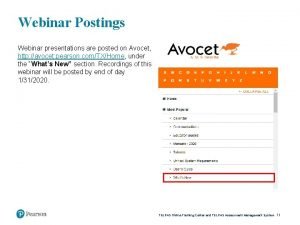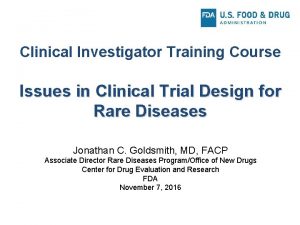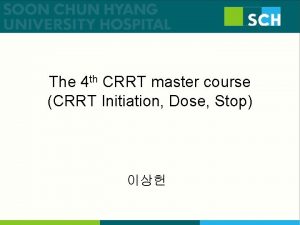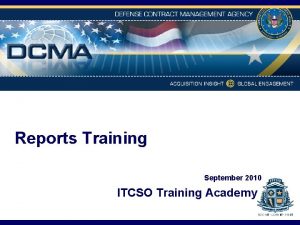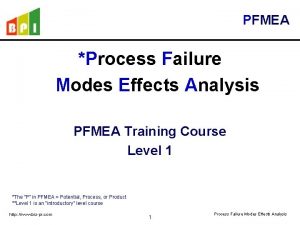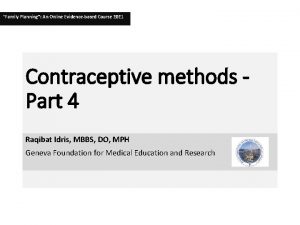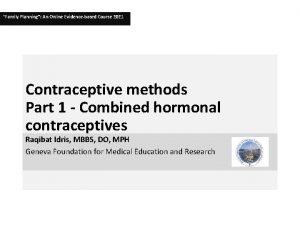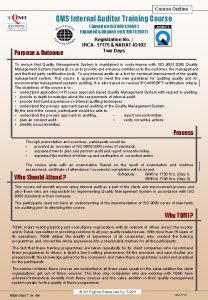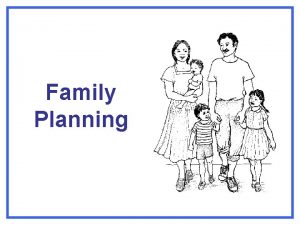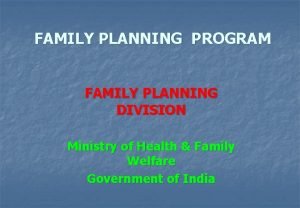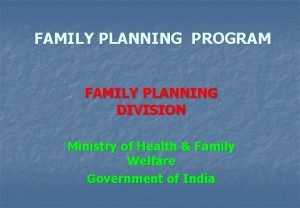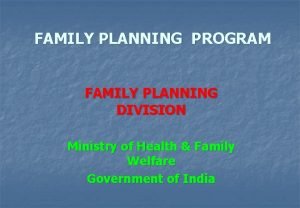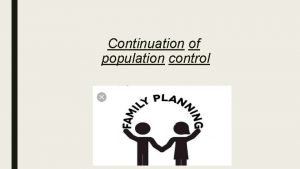Training course in family planning 2021 Family planning


























- Slides: 26

Training course in family planning 2021 Family planning services during the COVID 19 pandemic Rita Kabra, MBBS, MPH Contraception and Fertility Care Unit Department of Sexual and Reproductive Health Twitter @HRPresearch

Training objectives By the end of this session, you should be able to: – Describe the rationale for continuing FP services during the COVID-19 pandemic – Describe the effect of COVID-19 on Family planning services – Apply WHO guidance to maintain FP services during the COVID-19 pandemic 2 Twitter @HRPresearch

Main benefits of family planning/contraception 1. Secures the well being and autonomy of women 2. Empowers people and enhances education 3. Supports the health and development of communities 4. Prevents unplanned pregnancy, abortion and pregnancy-related health risks of women 5. Prevents adolescent pregnancy 6. Reduces infant mortality and prevents HIV/AIDS transmission to newborns 7. Slows population growth 3 Twitter @HRPresearch

Meeting the unmet need for contraception across the reproductive cycle in low- and middle-income countries and offering all pregnant women and their newborns the standard care would result in : – – reductions of unintended pregnancies by 68% unsafe abortions by 72% maternal deaths by 62% neonatal deaths by 69%. * Recommended by the World Health Organization (WHO) * Adding it up: investing in sexual and reproductive health. New York, NY: Guttmacher Institute, 2020. 4 Twitter @HRPresearch

Rationale • The COVID-19 pandemic is posing unprecedented challenges to governments and health systems. • The direct impact of the pandemic is already significant; however, evidence suggests that the most important effects will be indirect. • In multiple settings, access and utilization of essential health services have been compromised. • According to surveys conducted by WHO, UNICEF, MOMENTUM 2 A, and others in previous epidemics, such as SARS in Taiwan and Ebola in West Africa, impacts on service utilization resulted in higher number of deaths than the disease outbreak itself. • Increase in unmet need. • Unintended pregnancies and its consequences. 5 Twitter @HRPresearch

FP Services during COVID- 19 pandemic § § § 6 Disruption or interruption in the provision of family planning services during the COVID-19 crisis may result in a dramatic increase in unintended pregnancies and need for abortion care. The Guttmacher Institute estimates that a 10% proportional decline in short- and long-term reversible contraceptive use would result in an additional 49 million women with an unmet need for modern contraception and an additional 15 million unintended pregnancies, over the course of a year. Maintaining essential services is crucial to protecting girls and women from the negative health consequences of unintended pregnancies, such as unsafe abortion and serious pregnancy complications, which contribute to maternal and infant mortality. Twitter @HRPresearch

FP services during COVID- 19 pandemic § § 7 Provision of modern contraceptives (short-term and long-acting), information, counseling, and access to services (including emergency contraception) is lifesaving and should be available and accessible during the COVID-19 pandemic. Ensuring access to contraception is fundamental to upholding human rights as well as contributing to improved health outcomes, as recognised in SDG 3. 7 for universal access to sexual and reproductive healthcare services. Twitter @HRPresearch

Source: CDC EFFECT OF COVID-19 ON FAMILY PLANNING SERVICES 8 Twitter @HRPresearch

Effect of COVID-19 on family planning services 9 Twitter @HRPresearch Source: Rita Kabra, Komal P. Allagh, WHO FP Accelerator project

Effects of COVID-19 on family planning § § 10 The full impact on family planning and women and girls' access to services still is not known, and will not be for some time Early assessment shows § Two-thirds of the 103 countries surveyed by the World Health Organization reported disruptions to family planning and contraceptive services (Pulse survey on continuity of essential health services during COVID-19 pandemic-Interim report). § Lockdowns and movement restrictions have impacted access to services and the availability of commodities and supplies. This is particularly true with long-acting reversible contraceptives (LARCs) as they require healthcare workers for insertion and removal procedures, as well as clients were afraid to go to health facilities. § This has implications for changes in the method mix, discontinuation rates for short-term contraceptive methods (STMs). Twitter @HRPresearch

An example of impact of COVID-19 on FP services in India Source: Times of India, 12 th July 2020 11 Twitter @HRPresearch

Response to maintain FP services during the pandemic 12 Twitter @HRPresearch Source: Rita Kabra, Komal P. Allagh, WHO FP Accelerator project

WHO GUIDANCE TO MAINTAIN FP SERVICES DURING THE PANDEMIC 13 Twitter @HRPresearch

LTH BA ITY UN MM MA CA L IN I CL Twitter @HRPresearch SED NA GE M GU IO NA L AT ER OP 14 HE A EN T IDE LIN ES CA RE WHO guidance to maintain FP services during the pandemic

Operational guidelines: Maintaining essential health care services § § § § § 15 Establish simplified purpose-designed governance and coordination mechanisms to complement response protocols. Prioritize essential services, including vaccination, care during pregnancy, childbirth and in the postnatal period, FP, care for young infants and older adults, mental health and psychosocial care. Optimize service delivery settings and platforms, including in alternative locations and models, community services, targeted outreach, and teleconsultation. Establish effective patient flow at all levels, including screening, triage, isolation of suspected and confirmed patients, targeted referral. Rapidly re-distribute health workforce capacity, including by re-assignment and task sharing, remote training. Maintain population trust to safely meet population needs and control infection risk. Fund public health and remove financial barriers to access. Strengthen communication strategies to support the appropriate use of essential services. Strengthen the monitoring of essential health services. Use digital platforms to support essential health service delivery. Twitter @HRPresearch

Operational guidelines: Maintaining essential FP services 16 Programming evidence-based guidance & tools – Support continuation of SRH services and triaging. – IEC materials- Information about delayed availability of LARCs (IUCDs, implants) and sterilization services until resumption of routine services. – Ensure adequate supply of contraceptive. – Guidance to expand self-care including self-injection of DMPA. – Standards for Infection prevention during IUD, PPIUCD and implant insertion (PP 16 ). – Telemedicine- strengthen outreach services. Capacity building/ Training of health care providers – Online training tools for health care providers on FP /PPFP. – Training FP providers on IPC standards and COVID 19 response. – Training material & job aids on use of PPE. Data support & monitoring – Standardized format for reporting COVID-19 cases among couples using family planning methods. – Monitoring last mile distribution of contraceptive and FP services. Twitter @HRPresearch

Clinical management of COVID-19 3 main sections 1. 2. 3. Guidance on infection prevention measures Modifications for safe delivery of services Transition towards restoration of activities https: //www. who. int/publications-detail/clinical-management-of-covid-19 17 Twitter @HRPresearch

1. Guidance on infection prevention measures: COVID 19 § § § § 18 Standards for Infection prevention during IUD, PPIUCD and implant insertion (PP 16 ). Use the mask for provider and client and positioning of patient to keep the coughs away. Optimize service delivery settings and platforms, including in alternative locations and models, community services, targeted outreach, and teleconsultation. Establish effective patient flow at all levels, including screening, triage, isolation of suspected and confirmed patients, targeted referral. Strengthen health workforce capacity, including by re-assignment and task sharing, remote training. Maintain population trust to safely meet population needs and control infection risk. Monitor & communicate about where services can be accessed. Twitter @HRPresearch

2. Modification for safe delivery of FP services § If a woman’s regular contraceptive method is not available, other contraceptive options (including barrier methods, fertility awareness-based methods and emergency contraceptives) should be made more readily available. § Relax requirements for a prescription for oral or self-injectable contraception and emergency contraception and provide multi month supplies with clear information about the method and how to access referral care for adverse reactions. § Enable pharmacies and drugstores to increase the range of contraceptive options they can provide and allow for multimonth prescriptions and self-administration of subcutaneous injectable contraceptives if available. 19 Twitter @HRPresearch

3. Transition towards restoration of activities § § 20 Plan for clients to return to longer-term reversible methods (such as IUDs specifically PPIUD, implants) and permanent methods (tubal ligation and vasectomy) if these services were disrupted. Assess inventory and maintain data related to forecasting procurement and distribution of contraceptives to avoid potential stock outs. Monitor and communicate about where services can be accessed. Use digital platforms, telemedicine, tele counselling where possible. Twitter @HRPresearch

Community-based health care (outreach and campaigns) during COVID-19 pandemic q q 21 Support trained community health workers to continue providing counselling at the community level about contraceptive options. Address users preferences for contraceptive methods that may change in the setting of the COVID-19 pandemic, based on potential disruptions of supply chains and limitations on access to health care facilities. Ensure that the community health workforce includes health workers who are appropriately trained to safely provide family planning services and information. Where appropriate, offer digital decision support tools to assist the community health workforce to safely provide contraception. Twitter @HRPresearch

Contraception/ Family planning and COVID-19: Questions and Answers (WHO-HQ, SRH) Is contraception/ family planning safe to use? I want to avoid getting pregnant. What can I do? I can’t access my contraceptive method of choice. What do you advise? What is the best contraceptive method to use? I want to change my contraceptive method – is this possible? I want to remove or replace my implant or IUD – can I do this? Why is providing contraception/ family planning, important? As a policy maker what can I do to ensure contraception/ FP access? As a programme manager how can I help people access services? 22 Twitter @HRPresearch

CONCLUSIONS: What do countries need to do to maintain FP services during the pandemic 1. FP and reproductive health services should be included in the package of essential services and develop strategies to ensure women and couple exercise their reproductive rights during the COVID-19 crisis 2. Reorganization of service delivery –physical distancing 3. Alternate models for service delivery – Tele Health and Private sector engagement 4. HR re-deployment, task shifting and capacity building 5. Ensure availability of drugs, Supplies & Equipment 6. Additional financial resources for the facilities 23 Twitter @HRPresearch Source: UNFPA

Additional reading § § 24 WHO guidance on protecting human rights under the COVID-19 response. Critical guidelines on the safe provision of sexual and reproductive health services in the COVID-19 context. The Inter-Agency Working Group on Reproductive Health in Crises (IAWG) developed a programmatic guidance specifically adapted to the COVID-19 crisis. International Federation of Gynecology and Obstetrics (FIGO) created a COVID-19 resource page on women’s health. Twitter @HRPresearch

WHO guidance to maintain FP services during the pandemic Operational guidelines on the safe provision of sexual and reproductive health services in the COVID-19 https: //www. who. int/publicationsdetail/10665 -332240 25 Twitter @HRPresearch https: //apps. who. int/iri s/bitstream/handle/106 https: //www. who. int/publicati 65/331975/WHO-2019 ons-detail/clinical-management n. Co. V-of-covid-19 Comm_health_care 2020. 1 -eng. pdf

26 https: //www. familyplanning 2020. org/covid-19 Twitter @HRPresearch
 Fbisd high school course selection
Fbisd high school course selection Saeta refresher course 2021
Saeta refresher course 2021 Solanco powerschool
Solanco powerschool Klein oak course selection
Klein oak course selection What is half brick wall
What is half brick wall Course title and course number
Course title and course number Course interne moyenne externe
Course interne moyenne externe Zeta phi beta mip process
Zeta phi beta mip process Pwcs concussion training answers
Pwcs concussion training answers Telpas online training center 2020
Telpas online training center 2020 Cognitive stimulation therapy training course
Cognitive stimulation therapy training course Weights and measures training course
Weights and measures training course Army tasp unit coordinator
Army tasp unit coordinator Adventurer uniform sda
Adventurer uniform sda Cabin crew training course in malaysia
Cabin crew training course in malaysia Winter driving safety presentation
Winter driving safety presentation Cognitive stimulation therapy training course
Cognitive stimulation therapy training course Clinical investigator training program
Clinical investigator training program Autotransfusion training course
Autotransfusion training course Ufr dose prismaflex
Ufr dose prismaflex Itcso
Itcso Pd
Pd Pto course
Pto course Pfmea training
Pfmea training Asbmt clinical research training course
Asbmt clinical research training course Bank reconciliation training course
Bank reconciliation training course Analytical thinking training course outline
Analytical thinking training course outline









